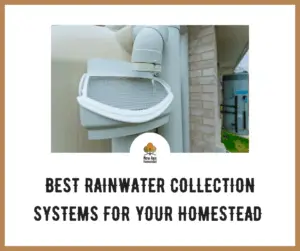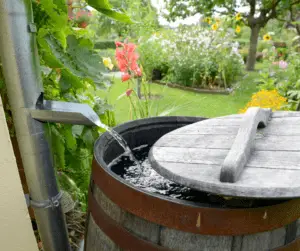If you’re looking for a guide that teaches you how to set up a rainwater collection system, you’ve found it.

Homesteading is living off-grid and being entirely self-sufficient, which means that all food and water must be sourced from within the homestead.
A prevalent tactic to source water is by collecting rainwater. Rainwater is one of the best ways we can source water, especially in rainier climates.
The best way to source rainwater is by installing a rainwater harvesting system, which is typically installed on the roof.
Once the rainwater begins falling into the catcher, it gets routed into a storage container, where a few processes occur.
I will cover the best rainwater harvesting systems to take away the guesswork, along with a few essential aspects to remember. Let’s jump into it now.
Best Rainwater Collection Systems: Top 5 Picks
Suncast Rain Barrel
If you’re looking for an all-around sound rainwater harvesting system, then the Suncast is going to be the right choice.
It’s super sturdy and durable, so it’s going to hold up well for the long-term. It has a capacity of up to 50 gals, which isn’t the largest, but it’s certainly enough if you are careful with how much water you use.
The only negative is that due to its wide stance, it’s not very tall, which means you’ll need to place it a little higher off the ground to have decent water pressure.
I’ve used one similar to this, and my fix was simply placing it on eight cement blocks, two high and four wide.
It includes a hose that can be connected to the rainwater harvesting system so that you won’t need to buy it.
Due to its low pressure, I would only recommend this barrel for supplementing the livestock water supply or gardening water supply.
Goplus Collapsible Rain Barrel
This is one of my preferences due to its portability. The Goplus is a collapsible rain barrel, which can quickly be folded up and transported anywhere.
The biggest use I see this particular barrel having is for water supplementation for you, the garden, or livestock.
This is because the goplus has a mesh filtered hole in the top center, filtering out any water that flows through.
This would be perfect to set up near a livestock pen or garden and hooking up to a water hose.
This would mean you’d virtually have water right where you need it, without having to transport it or run long water hoses.
Sure, it’s still worthy of household use, but not entirely meant for it. It’s best if you have other uses that prove challenging to transport water to, like the mentioned pens or gardens.
Graf Mondo Rain Barrel
Moving up to a much larger size, the graf mondo will be a step above the other barrels. It’s a massive 137 gallons, so it will be plenty large enough for most applications.
Due to its overall larger capacity, it’s going to have much higher water pressure. You won’t have to elevate it unless you prefer really strong water pressure.
The barrel is made of a very rugged material, capable of withstanding years of usage. This barrel will be an excellent choice for you if you live in an area that does not get much rain.
That may seem backward, but it would benefit you when it does rain, too, as you’ll be able to store much more of it to keep long-term, especially in places like Arizona.
If you dwell in a region that receives a lot of rain, I’d recommend an even bigger one, or a few smaller ones.
FreeGarden Rain Barrel
This is going to be the best all-around mid-sized rain barrel as it’s straightforward in design and, due to its tall structure, can provide a decent amount of water pressure.
It’s not the biggest at 55 gallons, but because it’s so inexpensive, you could consider placing a few or more around the homestead to collect rainwater.
It has a simple nozzle placement near the bottom, although it’s elevated, which means you won’t be able to use every gallon inside unless it’s tipped to the side.
The unit does appear to be very sturdy, though, and is an excellent addition to any homestead.
The only refutation I see is that it has a flimsy top. It’s not a deal-breaker, but after a year or two of opening and closing, there’s a concern about breakage.
Autopot 265
Finally, the autopot is an enormous 265-gallon water barrel system.
This water barrel will suit those of you with a bigger need for water, such as having a family or large livestock, like cows.
If you placed a few of these on your property, you get a thousand gallons of water. Just think about it.
The building is very sturdy — which it should be at this price, and it has a measuring system on the side to determine the water level easily.
It’s tall and large, so water pressure is not going to be a worry. The only negative that is seen with this water barrel is that it’s stitched together.
The material is of outstanding quality in itself, but this isn’t exactly the best design, as the material could be ruptured if a sharp object is thrown at it.
However, you really can’t get any better at this price point, and considering its size, I’d highly recommend it.
How To Catch Rainwater
The Roof
Using the roof is by far the most common option used to collect rainwater. Typically, most people install particular gutters that redirect the rain onto the top into a hose.
After it reaches the hose, it travels into the storage barrel.
This is an excellent option if you have a decently sized roof. You’ll just need to make sure you keep it clean of debris, so nothing gets stopped up or clogged.
I’d recommend at least a mesh filter over the hose, which will prevent leaves and other debris from getting into the hose and barrel.
You should know that if you have an asphalt roof, it may contaminate the water with pebbles or other unwanted materials that could be challenging to filter out.
Tin roofs and roofs made of metal will be the best option to avoid this, as there are no worries of added debris getting mixed into the water.
Drainage Ditch
This option may not seem like the most appetizing one, but if filtered adequately enough, it can make for an excellent rainwater source.
You should find an area in the shape of a bowl, a site where water collects up to an inch or two, or place it near a hill and catch the runoff.
The trench can be as long as you’d like, but it should be at an angle with the lower end at the storage barrel.
This causes the rainwater buildup to fall into the trench, and at this point, the water will flow down the ditch and into the barrel, which should be underground.
You’ll need to pump the water out manually yourself, but this is a sure-fire way to source rainwater, especially if you have a small roof.
You should lay down a plastic barrier in the trench and place rocks inside.
This will prevent the ground from soaking up the water before it reaches the barrel, and it’ll stop any debris from flowing along with the water.
A Tarp
If you do not have a roof that’s large enough to catch water, then perhaps consider laying out a tarp in the shape of a pool.
If it’s wide enough, it can make for a perfect rain-catching system. The only thing you should remember to do is place it at the level at which the water storage will be.
Nevertheless, even if you catch rain on the roof, using a few tarps can help you capture and store a lot more rain than you otherwise would have.
Many tarps are not entirely water-resistant, especially when pressure is added, so make sure whichever tarp you buy is a quality one.
You may also consider a small blow-up pool; as these can easily catch rainwater, the only negative is that it will need to be pumped out.
A Few Tips
Repurpose The Greywater
If you’re going to utilize the rainwater for bathing purposes, then you could repurpose the water to use for watering the garden, washing equipment, and more. Simply draining the water back into the earth is a waste of resources. A bathtub full of water could be put to fair use and simply rerouted into a greywater storage tank. You could also use greywater as toilet water, which would save you big time by not using fresh water to flush the toilet.
Use A Rain Chain
If you do not have gutters, then placing a barrel underneath the roof where the most rain falls may work, depending on the top. To make sure the rain gets into the bucket, hang a chain from the roof down into the bucket. This will help prevent the water from having a mind of its own and splashing everywhere but into the barrel.
Turn Snow Into Drinking Water
If you live in a snowy area, rain may be a rare occurrence during winter; instead, you’ll have snow. Luckily, snow can easily be converted into drinking water by using filtering cartridges, UV lights, or by boiling. Otherwise, it may prove challenging to have enough water during the wintertime, as it’s kind of hard to source rainwater when it’s below freezing.
Open Questions on Rain Harvesting Systems
Are Rainwater Harvesting Systems Worth It?
If you have other options on your property, such as a creek or large pond, they’re not necessarily needed because water could easily be sourced from those areas.
However, most people aren’t going to have a creek or a pond on their property, so in this case, they are entirely worth it.
Determining if it’s a good option for you depends on your climate, as they’re best for regions that receive lots of rain.
Is Collecting Rainwater Legal?
I’ve written many articles about off-grid laws, and one question that often comes up is whether or not rainwater harvesting is legal.
In most states, rainwater harvesting is legal. However, a few states may require you to have a permit, though the chances are slim.
Most states encourage rainwater harvesting, which isn’t surprising as it saves city water. This is the way it should be; it’s mother nature’s gift.
How Can I Filter Rainwater?
Most rainwater harvesting methods will result in the water having at least a little bit of debris, which can be removed by filtering it using a few different approaches.
There are several ways to filter water, but the best is by using a cartridge filter, which will remove the majority of microorganisms and debris.
Lastly, using an ultraviolet system will disinfect the water, making it safe to drink, which happens after the water flows through a mesh filter, then the cartridge filter.
Verdict
Rainwater is a gift from mother nature, and if we want to use it to our advantage, we should be able to catch it properly.
Many people think it’s as easy as catching and drinking — but some steps should be followed.
You’ll need gutters that are covered in mesh, and a hose connected to the end, another mesh filter, followed by a barrel to store it in.
I recommend investing in a filtering system meant for rainwater. Many are used for wells, but you’ll need more pressure on those to work.
Ensure each barrel is elevated a few feet at a minimum above each water outlet, such as a faucet or showerhead.

